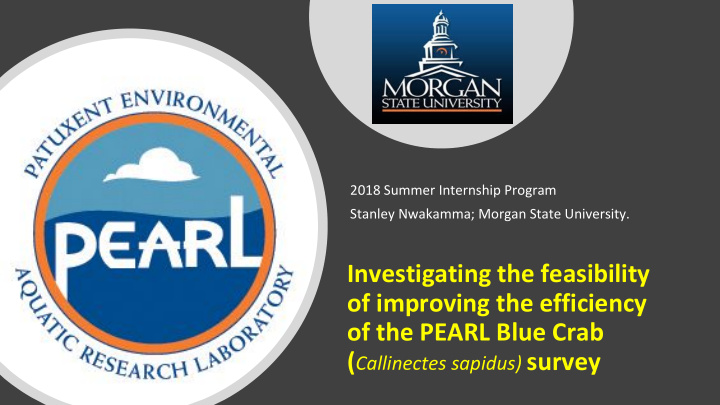



2018 Summer Internship Program Stanley Nwakamma; Morgan State University. Investigating the feasibility of improving the efficiency of the PEARL Blue Crab ( Callinectes sapidus) survey
• $54.4 million to Maryland’s fishermen in 2016 • It is the most valuable fishery in the Chesapeake Bay The PEARL Blue Crab survey • This is the 50 th year of this study. • George Abbe started this study. • Sampling sites are located in both the Why are long Chesapeake Bay and the Patuxent River. term surveys • Objectives of the survey? important?
The traditional method of baiting allows for fewer numbers of samples Investigating to be counted in the analysis. the feasibility of improving A more efficient method of baiting has the efficiency been proposed and must be evaluated before modifying the 50-year study. of the PEARL Blue Crab survey This study will document whether the proposed change will introduce a bias into catch metrics.
Determine if the new baiting method captures crabs similarly to the traditional method. H 0 : There is no significant difference between the number of crabs caught using the Traditional (Trad) Objectives baiting method and the New baiting method, during my sampling. (Trad = New) H A : There is a significant difference between the number of crabs caught using the Traditional (Trad) baiting method and the New baiting method, during my sampling. (Trad ≠ New)
Line 1 Paired sample Line 2 Paired sample Methods Half of the pots at the sampling site will be baited using a new baiting method – bait is replaced completely each day. Half of the pots at the sampling site will be baited using the traditional baiting method – adding a fresh bait to the old bait on the 2 nd day of trapping. The differences in the catch for each of the two methods will be analyzed.
Sample Data not Normally Distributed
• H 0 : There is no significant difference between the number of crabs caught using the Traditional (Trad) baiting Wilcoxon method and the New baiting method, during my sampling. (Trad = New) Paired- Sample • H A : There is a significant difference test. between the number of crabs caught using the Traditional (Trad) baiting method and the New baiting method, during my sampling. (Trad ≠ New) • Let α = 0.05
n = 8 T + = 4 + 6 + 6 + 2 = 18 T - = 6 + 2 + 2 = 10 Critical Value of the Wilcoxon T Distribution: T α (2), n = T 0.05 (2),8 = 3 Results (If either of the positive or negative differences is less than 3, the null hypothesis will be rejected) Since T + > 3 T - > 3 H 0 is not rejected .
Findings There is no significant difference between the number of crabs caught in our sample, whether using the traditional or new baiting We could still have a β , or methods. The baiting method does not significantly affect the “Type 2” error, because outcome. sample size is small. Why is this important?
Summer 2019 Intern Applications will be accepted from Jan. 1 st 2019 to March 1 st 2019 It’s open to all Undergraduate and recently graduated students, regardless of national origin or citizenship status. Morgan State University Students are strongly encouraged to apply! For more information, please contact: Richard Lacouture Phone: 443.885.5935 Email: richard.lacouture@morgan.edu
Recommend
More recommend